The New Orleans elderly community ‘left to die’ after a hurricane
After Ida made landfall on August 29, 2021, residents of a senior living facility were plunged into ’12 days of hell’.
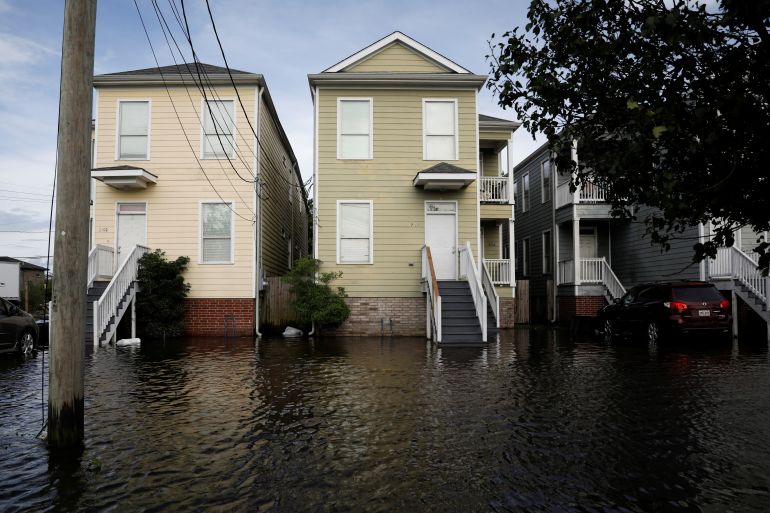
New Orleans, United States – Hurricane Ida was not Michael Corolla’s first storm.
As a young merchant seaman, he weathered three separate hurricanes in the open ocean, riding supertankers up the crests of 15 metre (50ft) waves in the middle of the North Atlantic. So as Hurricane Ida barreled towards New Orleans on August 29 last year, he figured he and his wife of 57 years, Charmayne, would be safe at Boyd Manor, the low-income senior centre where they lived on the ground floor. They had moved into the three-storey apartment building, close to the Mississippi River, about a year earlier. This would be their first serious hurricane at Boyd.
Keep reading
list of 4 itemsAfter the Hurricane
World’s coral reefs face global bleaching crisis
Why is Germany maintaining economic ties with China?
“We knew it was coming,” 80-year-old Michael recalls as he stands in the shade under the building’s portico months later. “But we didn’t know it was going to be that bad.”
By 10am, the lights had flickered out. Air conditioners had rattled into silence. The refrigerators, nebulisers, and oxygen therapy machines of the 39 residents were powerless. By noon, the storm had crashed ashore with 241 kilometre-per-hour (150 mph) winds. Rain began to stream in through Boyd Manor’s windows and from underneath the front door.
Michael, who has chronic obstructive pulmonary disease (COPD), and 79-year-old Charmayne, who has lupus, went to sleep on the night of August 29 with the storm still raging. At around 4am, Michael woke feeling unwell. Since the power had failed the day before, he hadn’t been able to take his albuterol, a breathing medication that requires a small machine to turn the medicine into an inhalable mist. In the dark and increasingly stifling heat, he sat up and swung his feet onto the floor.
They landed in water.
“I said, ‘Oh, Jesus. There goes my shoes,’” Michael says.
Lined up neatly by the door, his sneakers were soaked. The water was only a few inches deep, but Michael could see small waves rippling down the hall. He feared it would get higher.
He couldn’t know it then, but the water – though it ruined his shoes, clothes, towels, bedsheets, and many of his belongings – was not the danger. Boyd Manor was about to experience what one resident called “12 days of hell”: no power, no lights, no air conditioning in 38C (100F) heat; no way to get food or water or charge medical devices. Boyd’s manager, typically on site during the day, would leave the property and ignore all pleas for assistance. Some residents would collapse. Others would be forced to ration medicine. By the time power was restored, at least 19 people around the city would be dead from the heat, according to data provided by the New Orleans coroner’s office. Almost all were seniors, but everyone at Boyd Manor survived.
This was largely thanks to the efforts of a few local, unpaid organisers, who realised what was happening and showed up every day to ensure the residents had meals and access to medical care.
Jordan Bridges, who grew up nearby and led the direct aid efforts for Boyd Manor, put it simply: “I just wasn’t prepared for what we found there,” he says. “These seniors were left to die.”
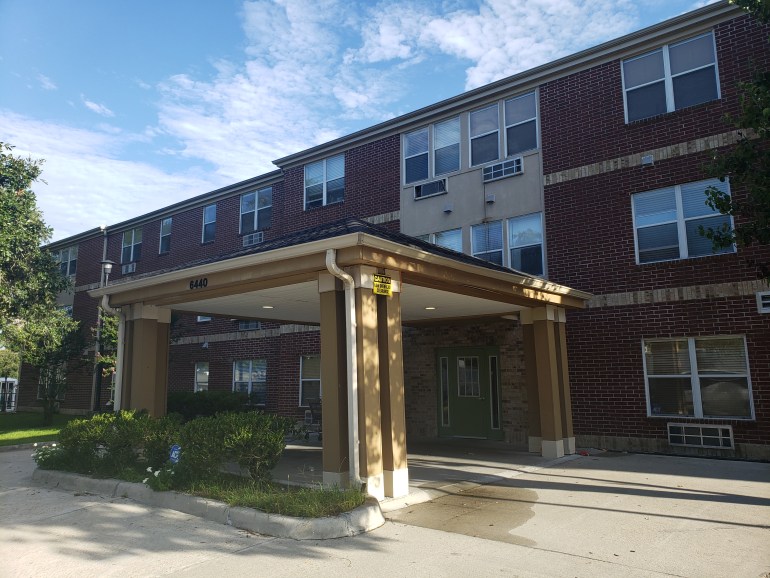
Day One: August 29
The storm arrives
Boyd Manor is an unassuming brick building across the Mississippi River from downtown New Orleans. The building is Section 202 property for the elderly, meaning it is subsidised by the United States Department of Housing and Urban Development (HUD). Every resident contributes 30 percent of their income towards rent – no matter the amount; even if it is a paltry social security cheque – and HUD covers the remainder. Boyd Manor residents are primarily Black, and most have pre-existing health conditions.
Long before the arrival of Hurricane Ida, residents say the building had severe problems. Windows let in rain. Cracks spidered up the wall. Mould and mildew grew on the surfaces of air conditioners, and water leaked down from spots in the ceiling.
As the storm approached, the city issued a voluntary evacuation. But resident Yolanda Lewis and local organiser Jordan say that management did not directly inform tenants of this. Yolanda, 59, says that when she’d lived at the nearby Renaissance Place complex, management had posted a sign-up sheet before a major hurricane for those who wished to evacuate. She’d expected the same at Boyd.
“People didn’t even know the storm was coming,” Jordan recalls. The 33-year-old artist-activist was born and raised in the Algiers neighbourhood of New Orleans, just a few minutes from Boyd Manor. When Hurricane Ida hit, he was busy running a campaign for state representative in his district. Lanky and energetic, he is a charismatic speaker with a generous smile. His affection for Boyd Manor radiates from him.
As the storm approached, Jordan was hunkered down at his house. He evacuated for Hurricane Katrina 16 years earlier, but still found Ida frightening. When the power went out that morning, he considered going to his parents’ house, but decided to ride it out at home.
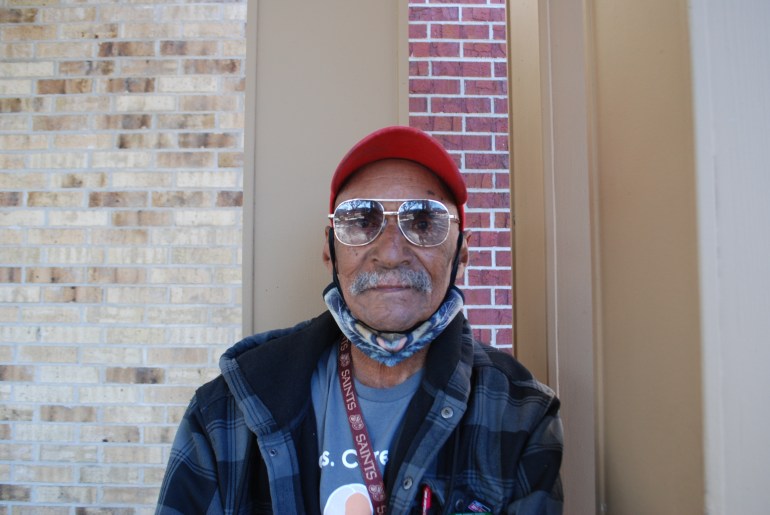
When the storm arrived, it wreaked havoc on Boyd Manor. James Betts, 75, who was living on the ground floor, describes how “It was raining through the windows. It was coming in so hard, I was sitting there watching water drip off my blinds.” Residents watched wind and water leaking through windows, coming under doors, and dripping from the ceiling. Pearl Stokes, 75, on the third floor, watched as a dinner plate-sized bubble formed on her ceiling.
On the second floor, the rain blew in and soaked Yolanda’s bed. She was forced to sleep on the floor, while her husband, Lawrence Joseph, 65, who has one leg, slept on the couch.
Upstairs, Pearl reached up and popped the bubble that had formed on her ceiling, sending dark water cascading onto the floor.
A few miles away, Jordan watched the same winds from his home. They howled; his floor jumped and shook. Massive branches cracked off the live oak tree hanging over his roof.
As darkness fell on that first day, one by one, tenants who had gathered just inside the front door to watch the storm together retired to their rooms. The hallways of Boyd Manor are windowless, and without lights, it was pitch-black inside.
At around 2am, with rain still pouring outside, Yolanda was carefully heading to the lobby with a friend to collect some candles her nephew was bringing for her, when they saw something in the stairwell.
“We see Mr Clarence in the stairway,” Yolanda recalls, still indignant on his behalf. “Two o’clock in the morning, he’s in the middle of the stairway, buck naked, with the wheelchair on top of him.”
In the dark hallway, another tenant, Clarence Lane, had gotten confused and accidentally tumbled down the stairs, where he wound up trapped under his own wheelchair. The hurricane’s eye had just passed, but emergency services still weren’t able to respond – in fact, 911, the emergency number, went down for 13 hours during the storm. Using dying mobile phones for light, the women woke two male residents, who managed to pick Mr Clarence up and take him back to his room.
By the time the sun rose, Hurricane Ida had devastated southern Louisiana, flattening homes, toppling transmission towers, tearing off hospital roofs, and leaving more than a million people in the state without power.
At Boyd, residents began to gather in the breezeway. A few miles away, Jordan, who had watched the storm all night, finally tried to get some sleep.
And then, as the rain thinned, residents stepped outside, where it was cooler, to see if anyone would come for them.
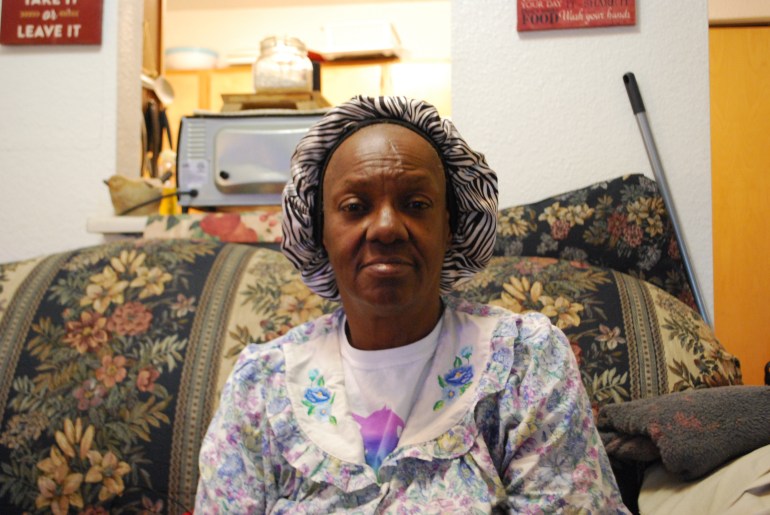
Day Two: August 30
‘Please don’t leave us here’
The residents of Boyd Manor largely spent August 30 waiting. They waited under the roof of the carport, as the surrounding driveway and streets were still under standing water. They waited for information. They waited for meals, or medicine, or evacuation.
Property manager Atrise Hunter arrived that morning, at around 11am, just before an ambulance came for Mr Clarence. When the ambulance left, so did she. Residents, including Michael Corolla and Yolanda Lewis, say the property manager did not answer their repeated calls nor return for 12 days.
“The whole time we were without power,” Yolanda says, “That woman didn’t check on us one time.”
Residents soon began to realise they were on their own.
“I went downstairs to sit out and see what was someone gonna do,” recalls Sandra White, a 72-year-old retired school employee. “And nobody did nothing.”
Because Boyd Manor is an “independent” living centre, it – unlike a nursing home – is not required to provide medical monitoring or 24-7 assistance. But residents of Boyd Manor are all low-income, with the food insecurity and limited mobility that comes with that. Soon, the food in their fridges would spoil. The heat would rise again. And those who ran out of medicine, or who needed medical devices, had no way to get more. Some, like Michael and Charmayne, had no phones and thus no way to even ask for help.
“All of us was scared,” says Sandra. “We didn’t know where we were gonna get our next meal from. We didn’t know where we were gonna get water from.”
Conditions quickly became bleak. Some elderly residents had to urinate outside, because the hallways were too dark for them to safely find their way back to their rooms, and management habitually locks the common ground-floor bathroom.
“We was hungry. We was thirsty. Half of us couldn’t change our clothes because we couldn’t get up in the building, because it was so dark,” Sandra explains.
As the residents of Boyd Manor began to realise the depth of their trouble, Jordan was getting organised. He and his good friend and campaign manager, David Jones, had already been working on a telephone hotline they hoped to use for community organising. David, 31, speaks of Boyd with a steady, determined kind of sadness, and he and Jordan are clearly a powerful team: “iron sharpens iron”, as Jordan describes it.
Jordan and David met 10 years ago, on a night that changed the direction of Jordan’s life. Jordan, then a university student, his brother, and several friends were out celebrating with a wedding party. They ran into David, who knew some of the wedding party members, and he joined the celebration. Just a few hours later, a member of the wedding party got into an altercation. When police arrived, they started “dropping haymakers” on Jordan’s brother, who had been trying to resolve the fight. “I mean I’m watching my brother’s head hit off the concrete,” he recalls. He notes that he, his brother and David are Black; the rest of the group were white.
When Jordan stepped forward to help his brother, he says an officer punched him in the face, shattering his jaw and knocking him unconscious, then dragged his body into the street. Jordan regained consciousness while he was being kicked and beaten by police. “I think I’m being jumped,” he says. “Then they flip me over and I’m getting handcuffed.” He spent the night in jail, where he says police spat at and harassed him, and he was charged with several offenses including assault of an officer. He spent months in and out of the hospital, and years recovering from the physical and emotional trauma and still has the scars around his chin to show for it.
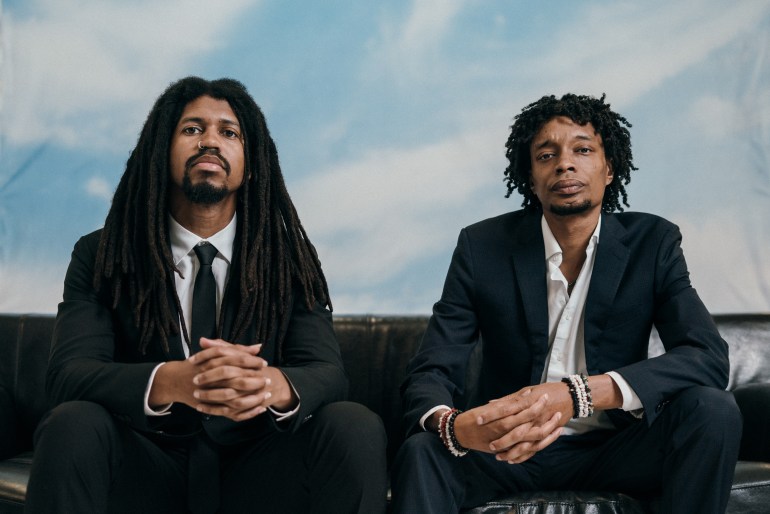
In recounting that night, Jordan begins to call it a unique experience, then stops. “I had a universal experience,” he corrects himself. He means that he had experienced violent brutality at the hands of a racist criminal-legal system, an experience shared by Black people across the US. It was a transformational moment for him. “That’s why I’m disgustingly optimistic,” he explains. “Because that’s all you have in those moments. ‘One day I’m not gonna be in this hospital bed.’ I understand now. I understand something they’ll never be able to take away.”
As Jordan recovered in hospital, David worked to hold the police who’d beaten him accountable, and thus their friendship formed around a keen appetite for justice. Once Jordan was discharged from hospital, he sought David out to thank him, and they’ve been a team since. Jordan was initially found guilty of resisting arrest, but cleared his name after a lengthy appeal; he is now in the midst of a federal civil suit against the Baton Rouge Police Department. Last year, Jordan and David co-founded an institute called The Novel Network and, through that, the community-care organisation Algiers Proud.
When the hurricane hit, Jordan and David repurposed their Algiers Proud hotline. Soon they were getting thousands of messages asking for help, and were able to distribute tens of thousands of dollars in aid. They also got in touch with the city to learn how they could plug into official efforts around food and water distribution.
Around this time, Jefferson Parish, which neighbours Orleans Parish where Boyd is located, began contacting managers of senior centres, demanding that those managers who had left return to the centres, and arranging for evacuations. Orleans Parish would not begin similar arrangements for days.
A spokesperson for the Office of New Orleans Mayor LaToya Cantrell told Al Jazeera that Orleans waited longer than Jefferson Parish because “other parishes were hit harder by the storm. Jefferson Parish was hit by stronger wind bands than Orleans Parish, and then they lost water pressure and had to do a post-storm evacuation.”
This statement about differing levels of risk, however, is inconsistent with how closely situated some of the Jefferson and Orleans senior centres are. For example, Jefferson Parish evacuated St Joseph Apartments, which are also on the Westbank near Boyd Manor, two days after the storm. Just 5km (3 miles) down the road, Garden Oaks Apartments, another low-income senior housing complex, was not evacuated, as it sits over the parish line in Orleans. There, an elderly Black man named Arthur Brown died of excessive heat on September 4 – six days after the storm, and just after Orleans began evacuations. Both parishes ultimately evacuated around 700 people each.
Across the city, with some cellular networks still down and power out everywhere, rumours began to circulate: Entergy, New Orleans’s power company, was saying it could take weeks, maybe even a month, for power to be restored in some places. At Boyd Manor, some residents went to a park next door to stay cool. Yolanda grew worried about her fish: she had 11 in a tank, including a foot-long one she had raised for three years named Killer Mia. The tank’s filter wasn’t working without electricity. Her husband has COPD, and Yolanda has asthma, but “not that bad”, she says: so she blew through the tube to try and oxygenate the tank. The fish swam in the dark. James Betts picked cold cuts from his melting fridge for a meal. Yolanda, with no electricity to clean or dry her bedroom set, settled back down to sleep on the floor. The residents lingering in the breezeway dragged themselves up the stairs before it got dark outside.
That evening at Boyd, Jimmy Bridges, 70, tried to rise from his bed, feeling deeply unwell from the heat. As he attempted to stand, he collapsed. With the battery he had left on his phone, he called his brother, who was able to pick him up and get him out. It was the first real sign of the dangers to come.
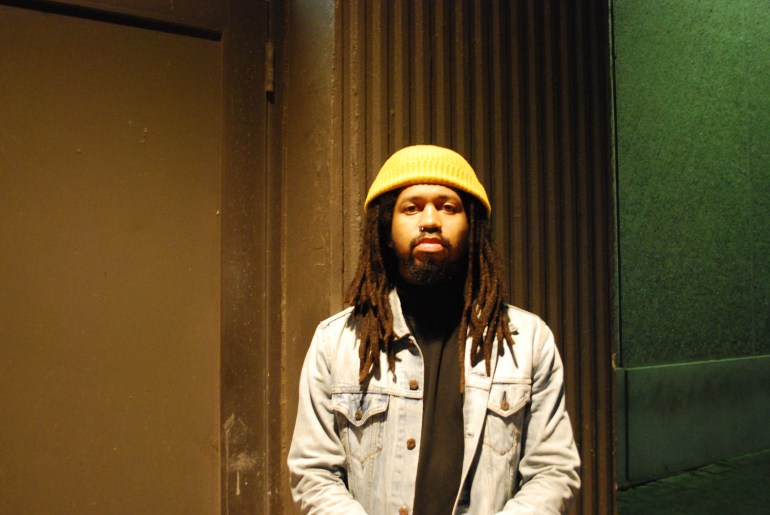
Day Three: August 31
‘On the edge’
The next morning, the heat began to rise.
With heat index values approaching 105F (40.5C), the National Weather Service (NWS) issued a heat advisory. Jordan and David headed to the Arthur Monday Senior Center, a complex from which they would distribute food, water, and tarps on behalf of the city.
Near Boyd Manor, John Preston was chatting with his neighbour, Tatania Riley. John works in the film industry, and had access to large battery generators. He had been hoping to use that equipment to assist people after the storm, and had already reached out to Jordan and David to try and plug in to aid efforts.
Tatania, who sometimes sells fried shrimp or crawfish bread across the street from Boyd Manor, had noticed residents sitting outside, listless and frightened. Some had asked her if she’d fry up food for them, since their electric stoves didn’t work.
“Mr John,” she said, “There’s a place around here that I don’t think anyone’s helping.”
So on his way to help at the Monday Center, John stopped by Boyd Manor. He was shocked by what he saw.
“These people were in deplorable conditions,” he recalls. “Very desperate. Everyone was sitting outside, they were scared, they were really scared. I see all this standing water, and they say, verbatim, ‘Please don’t leave us here.’”
John pledged to return, and continued on to the Monday Center, determined to bring back aid. Jordan and David were already waiting to help then-City Councilmember Kristin Palmer distribute food, water, and blue tarps for covering roof damage to an estimated 4,000 waiting residents. The situation was growing tense. People in line were increasingly frustrated because distribution hadn’t yet begun, while the supplies sat ready, stacked on tables in the heat. “The issue was that they weren’t trying to distribute the food until the media and cameras and stuff really got rolling,” Jordan says.
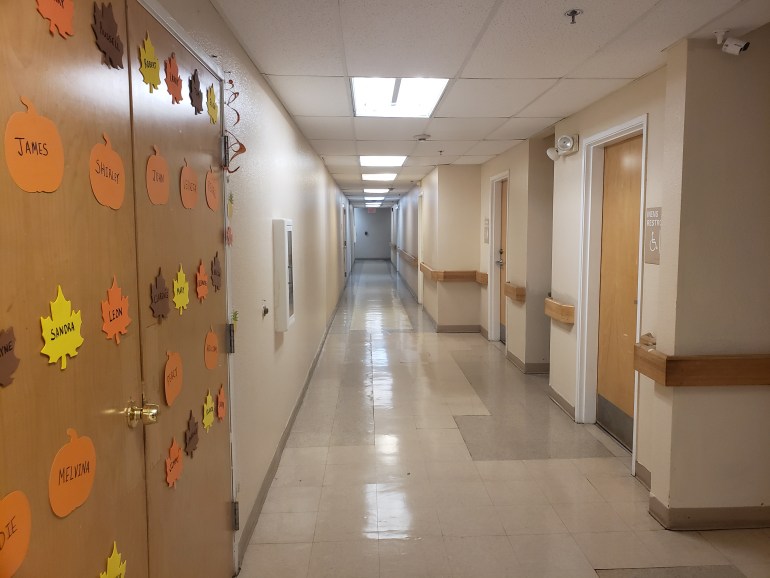
Upon arriving, John says, he tried to press the direness of Boyd Manor’s situation on Kristin Palmer, but she brushed him off. “She told me she knew what was happening when I tried to bring it up,” John says. “Then why was no one there?”
“They definitely had somewhat of an altercation,” Jordan recalls. “He confronted her, and she blew it off … Then she approached me and was like, ‘Don’t bring him back tomorrow.’”
In a phone interview, Kristin Palmer vehemently denied that she was waiting for the media to arrive before distributing supplies, and rebuked John’s accusations. “People are frustrated, people are waiting in line. What do you expect when you have all that need? But for him to say that is insane. We were efficient. I set this thing up, I had the city make that centre available for a year [due to COVID-19] before [John] ever walked in there. So for him to say that is ludicrous.”
John says the city councilmember’s team went on to distribute all the hot meals without reserving any for Boyd Manor, whose apartments all have electric stoves, meaning the residents had no way to cook. John, now seething with frustration, began to load up his pickup truck with all the supplies he could from what was left over at the Monday Center: nonperishable food, ready-to-eat emergency meals called MREs, fruit, water, cleaning supplies, and snacks like chips and popcorn.
Jordan and David had listened to John. “We didn’t ask permission,” recalls David. “We packed up stuff, loaded the cars, drove there, and saw that this was a life-or-death situation.” By about 4pm that afternoon, John, Jordan, and David were setting up at Boyd Manor.
They immediately recognised that the residents were in acute distress. “Sandra [White] comes out gasping; Michael [Corolla] comes out gasping,” Jordan says. In the sweltering weather, Sandra and Michael were just two of the residents struggling to breathe due to the severe heat and pre-existing health conditions. “People were stumbling out of the building,” Jordan says.
“They looked like death,” David recalls. “Literally, like … a lot of them were on the edge. You walked in and opened the door and there was water, standing water all over the first floor of the building.” Jordan and David sloshed down the hallways to try and get an idea of what was inside. In the pitch black, they noted that residents had put down newspapers in the corridor to try and soak up some of the water.
When residents explained that they needed power for some of their medical devices, John began to charge them with his generator. Jordan, who has been diagnosed with asthma, rushed to his home nearby, where he had two nebulisers. He brought them back, providing relief for residents like Sandra and Michael. Residents charged their phones in order to contact family, in some cases asking to be picked up.
It was the beginning of a routine that the men would repeat each day until the power returned: every afternoon, they sent lunch from the Monday Center to Boyd Manor. Before evening, they brought dinner, water and medicine; gave people rides to pharmacies; and provided whatever support the residents needed before assisting them to their rooms before dark.

Day 4: September 1
‘Bedbugs, black mould, pest infestations’
The next day, the NWS issued another heat advisory as the heat index climbed to 106F (41C).
Jordan and David spent another day distributing supplies at the Monday Center – in fact, they’d been so effective that Councilmember Palmer asked them to simply take over the on-site distribution work. After volunteering for hours, they drove along still-flooded streets to arrive at Boyd with food. Jordan distributed two of his own inhalers to Clayton Faggin, 70, and another resident. As they helped the Boyd community, new problems were continually arising.
In the heat and humidity, James Betts had noticed something disturbing: visible mould and mildew were beginning to grow on his furniture, spidering across his couch and bed. In another ground-floor room, Clayton, a veteran planning for a Valentine’s Day wedding, had already had mould and mildew in his room, but now it was spreading rapidly.
Jordan and David, aware now that Boyd Manor’s issues predated the hurricane, took the contact information of every resident and began documenting the problems: mouldy walls, leaking windows, tiles that had collapsed out of the ceiling. Residents warned them not to sit on the common area furniture because it had bedbugs.
“Mould, watermarks, leaks,” David notes. “Bedbugs in the couches. Black mould in rooms and common areas. Crumbling sheetrock. Pest infestations.”
At this point, the hot water had run out. Some residents would keep themselves clean with wet wipes and hand sanitiser. James used a sponge to give himself what he called a “schoolboy bath” with cold water. On the third floor, Pearl Stokes noticed that her insulin had gone bad. On the floor below her, Yolanda Lewis discovered the same about her husband’s insulin. She then checked the aquarium and the fish she had been keeping alive. Killer Mia was dead.
At this time, Boyd Manor’s Nashville-based property management company Taliafaro, Inc billed every tenant rent, despite the uninhabitable conditions and lack of power during a Presidentially Declared Disaster (PDD). Yolanda’s rent had, in fact, increased slightly.
The heat was constant and unrelenting. In the evening, when Jordan got home, he briefly thought he had hot water, before realising that it was his own body warming the bath.
Day 5: September 2
‘Like a crazy clown hospital’
After days without power, the building had become difficult to tolerate. The temperatures inside were sweltering. As tenants opened windows for air, bugs and mosquitos got in. Water still stood in places, and the mould was spreading faster. A smell was spreading, too: throughout the building, the food in everyone’s refrigerators had spoiled, a blow for a group that is already largely food insecure. Pearl estimates she lost more than $500 worth of groceries. Jordan and David helped tenants empty the rot into garbage bags.
“It was miserable,” explains James Betts. “No lights, no nothing.” James wore rain boots inside due to the water on the floor.
“It was like a crazy clown hospital at night,” Jordan says. “I could stick my hand in front of my face in the hallways and not see anything because it’s pitch black.”
Simultaneously, around town, the heat began to take a lethal toll.
That day, across the city, Donald Stratton, 76; Corinne Labat-Hingle, 70; Iley Joseph, 73; Abraham Causey, 68; and Arthur Brown, 88, died due to excessive heat. Most were living in income-restricted senior living complexes. Brown’s apartment building was just 4km (2.5 miles) from Boyd Manor.
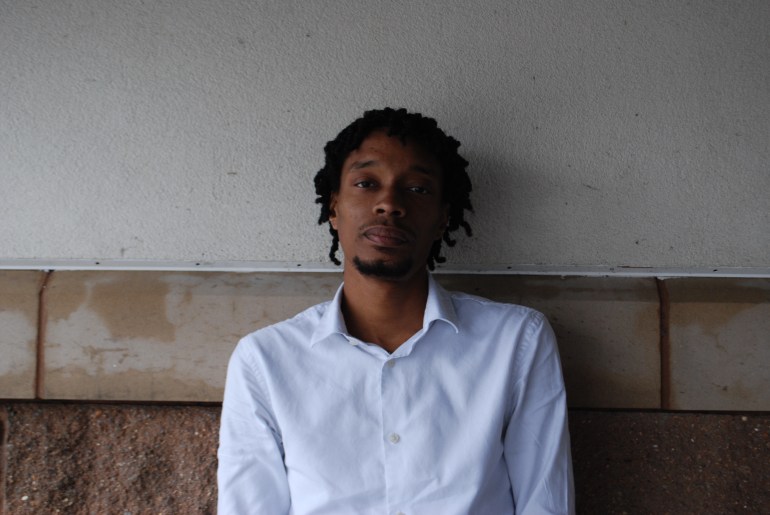
Day 6: September 3
Unheeded pleas
At this point, Yolanda could smell the mildew throughout the building. Residents continued to try to stay cool, using ice and sports drinks that Jordan and David brought.
James’s daughter arrived, and was so struck by the extent of the mould in his apartment that she insisted he could not stay there and took him back to Houston with her.
Jordan and David began knocking on doors each day to ensure no one was inside incapacitated.
On this day, David Sneed, 65, was found dead from excessive heat at his senior living complex across the river when his pastor and friend of 40 years came to deliver supplies. This was also when – five days after the storm – the New Orleans Health Department, realising the danger posed to seniors, began checking on senior living centres around the city. They evacuated residents from two centres, including Renaissance Place, where Yolanda used to live.
Jordan and David say they pleaded from the beginning, and repeatedly – to Palmer’s office and other officials – for Boyd Manor to be evacuated, but their pleas went unheeded.
Palmer, for her part, says that she did advocate for the residents of Boyd, and made repeated visits to Boyd Manor, bringing food. Yolanda recalls her coming half a dozen times. “I went directly to Avegno [Jennifer Avegno, the health department director] to get a group out there to Boyd,” Palmer recalls. But it was a chaotic time, and “they were slammed all over the city”.
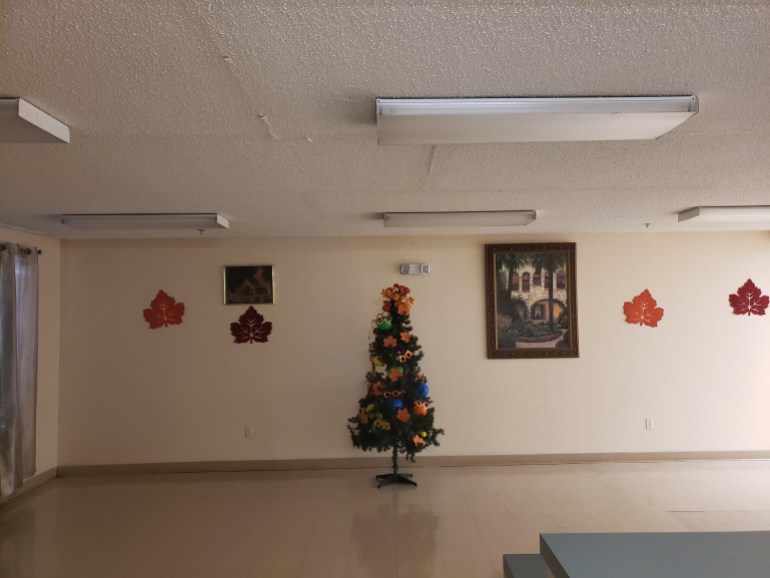
Day 7: September 4
‘If it’d been white and middle class’
By this point, Yolanda’s husband, Lawrence Joseph, had not had insulin for four days. He was so fatigued that Yolanda had to make him leave their apartment, with the help of Jordan and David, to go downstairs and lay outside on a blanket where it was cooler.
John Preston invited his friend Malik Rahim, a 74-year-old seasoned activist and former Black Panther, to witness what was happening at Boyd Manor. At the senior centre, Malik discovered an old friend: Clayton Faggin. Clayton and Malik met when Clayton’s older brother was acting as a mediator after a shootout between the Black Panthers and the police in 1970.
Malik was struck by what he saw at his friend’s home: in addition to the mould and lack of power, the plumbing had now backed up. The stench was so powerful that Malik had to turn around while climbing from the second to the third floor. He encouraged Clayton to try to leave due to the extensive mould, which had grown so severe he could see and smell the spores, which made him feel sick for days afterward.
“I know they saved lives,” Malik says of Jordan and the others, and not just through their supply delivery. “Not everybody would sit in the midst of a disaster and hear the problems of somebody else. And that’s the thing they did. They provided hope,” he adds. “That was the main thing that was absent. People had given up.”
Malik, who founded Common Ground Collective in the wake of Hurricane Katrina, was especially struck by parallels to that storm’s aftermath.
“It brought back all the old memories of after Katrina,” he says gravely, adding, “It was heartbreaking. Everybody knows that it shouldn’t have happened. If it’d been white and middle class, it wouldn’t have happened.” Malik was dismayed that the city seemed to be so ill-prepared for Ida, and did not sufficiently work with community groups like Algiers Proud. He feels it is shameful the city never recognised the work Jordan and the others did.
Meanwhile, the New Orleans Health Department evacuated eight more senior centres, and discovered the bodies of Myron Jones, 65; Clarence Washington, 79; Deborah Anderson, 74; Walter Jeanmarie, 57; and Reginald Logan, 74. All had died of heat-related causes, and all were Black. Logan’s body was found after a neighbour noticed flies in his window. In total, of the 17 people who died of heat-related causes in the wake of Ida at home or in senior centres, 13 were Black.
Day 8: September 5
‘I almost fainted’
The heat index remained above 100F (38C) as Algiers Proud members delivered ice and other supplies. Residents had trouble sleeping in the heat and humidity, and many were exhausted. Even able-bodied Jordan and David suffered – they were working 16 plus hours per day, skipping meals, and then barely sleeping in their sweltering homes.
Michael and Charmayne Corolla were struggling more and more with their health. Charmayne said she “couldn’t breathe, it was so hot. I had to go outside to try and get air. I almost fainted many times. It was awful.”
Keith Law, 65, died from heat-related causes in his Westbank home, about 7km (4 miles) from Boyd Manor.
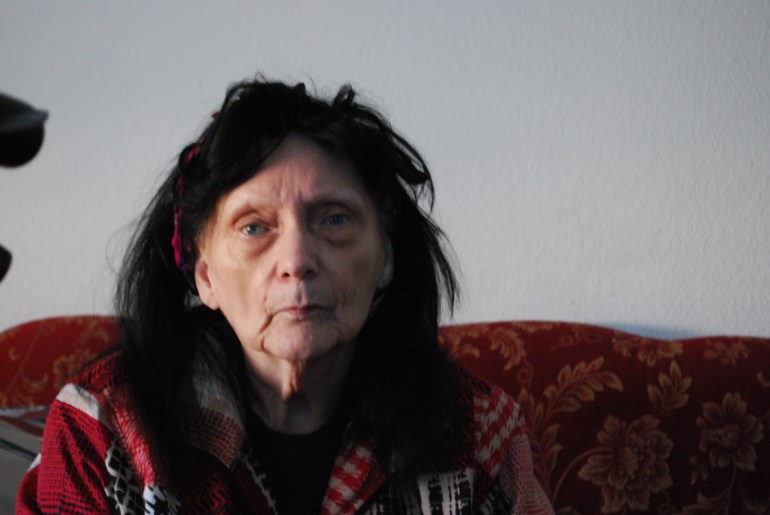
Day 9: September 6
‘Couldn’t sleep, couldn’t even think’
Yolanda finally managed to reach a pharmacy, where she bought $300 worth of insulin for her husband. Between the cost of the insulin, and the expense of replacing her bed and other belongings, now damp and mouldy, she ended up behind on her rent.
Michael and Charmayne’s health continued to decline.
“I was very sick,” Charmayne recalls. “Couldn’t sleep, couldn’t even think.”
Jordan and David brought Ensure (a nutritional meal replacement shake), ice, and other supplies to help residents keep their strength up, as well as flashlights, cleaning and personal hygiene supplies, and other needs like eyeglasses. During the day, they were also still running the distribution site at the Monday Center, handing out thousands of hot meals to other powerless residents.
Benjamin Gloger, 45, died of heat-related causes in his home across the river.
Day 10: September 7
‘Worse and worse’
John was growing increasingly worried about Michael and Charmayne. He had brought them to pharmacies several times, but now they were both struggling to breathe, and though he was bringing them a breathing machine to use each evening, he feared they wouldn’t survive Boyd Manor. He insisted they come to stay with him.
“It just got worse and worse, until John says, ‘Come to my house, because one of y’all is gonna go,’” says Michael. The couple agreed.
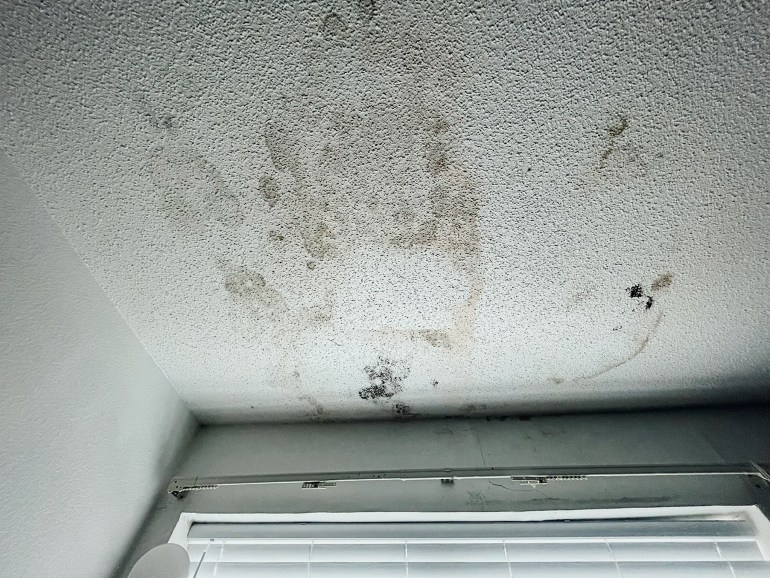
Day 11: September 8
‘Mould and mildew everywhere’
Ten days into the power outage, helpers from the Footprint Project, an organisation that assists with disaster recovery, came and distributed portable battery packs and headlamps. As they did so, Clayton Faggin, who had COPD and emphysema, used his black pickup truck to run a power cord through the window of his ground-floor apartment to power his oxygen machine.
James Betts came back, discovered that Boyd still did not have power, and evacuated once again with his other daughter, to Gulfport. “She said, ‘Daddy, you can’t stay in this, so much mould and mildew everywhere,’” he recalls.
The mould continued to spread. In a video taken weeks later, after power returned, mould was still visible everywhere: thick on the arms of James’s faux-leather couch; on his clothing; spidering across the top of his sugar jar; even growing on the burners of the stove.
At John’s house, Michael and Charmayne’s health began to improve.
Across town, Leroy Woodfork, 58, died from the heat in his home.
Day 12: September 9
The lights came on
Thanks to the continued advocacy efforts of Algiers Proud, a local news station came out to do a story about Boyd Manor. In the news footage, Sandra White can be seen weeping. James said he never got any sleep.
But that night – at last – the lights came on.
The aftermath
‘Blood on their hands’
But the effects of the power outage did not end when the electricity returned.
Jordan and David continued to provide support: a week later, they arranged for a group of medical students to visit Boyd and conduct wellness checks, where they discovered some residents were still rationing insulin, and that tenants’ pre-existing health conditions had worsened as a result of the conditions in the building. Jordan and David were also present when a man who told them that he’d been sent by Taliafaro to clean Boyd up carried out room inspections to assess the damage from the storm. At that time they were able to obtain copies of the inspection documents, which they say were fabricated and contained inaccurate information downplaying the conditions of the rooms.
Tenants say they were told they would not be charged rent for the period they went without power, but every resident was, in fact, billed full rent. Sandra now owes back rent. Yolanda has been threatened with eviction. She has begun working part time at a nearby Waffle House in order to recover financially, occasionally working 14-hour double shifts.
Major repairs requested by residents still have not been made. Sandra says she still has to put down a towel by her window when it rains. James reports there is still mould in his air conditioning unit. Pearl’s AC unit is so mouldy she won’t turn it on because it nauseates her; instead, she relies on electric fans. Yolanda can hear the wind rushing in beneath her AC unit. Little brown frogs hop up into her apartment through a gap next to the unit and die in the sun on the inside window ledge. She has named the one surviving fish from her tank “Soldier”.
“Conditions inside haven’t changed,” David says.
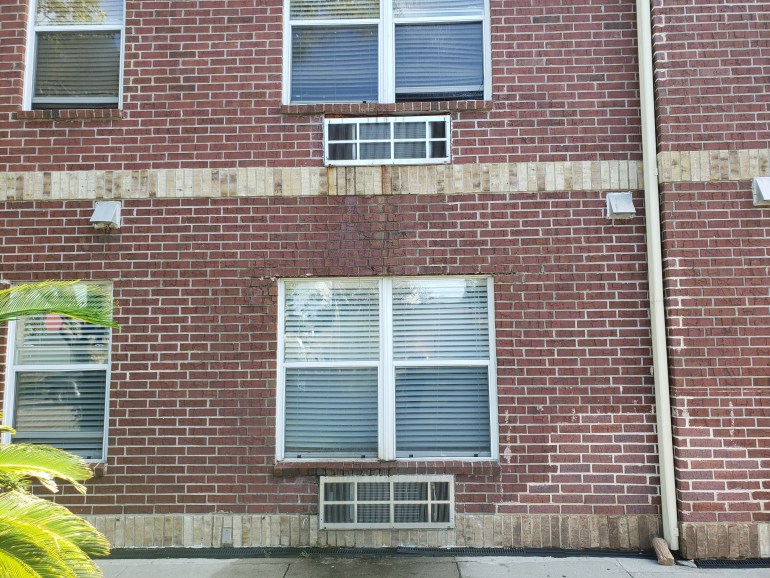
One resident, John Fondren, 71, who lost his mattress and the base of his bed in the rain that leaked under the window, also had to cut up and remove a section of mouldy carpet himself. He replaced it with a patch of carpet he found outside. He says management did not help or compensate him.
Michael and Charmayne’s apartment was in such poor condition that they were moved to a different unit on the second floor.
Eventually, management threw James’s mouldy furniture away. He says they never compensated him for the loss of property.
Jamie Paulen is a lawyer who works with local organisers on behalf of historically disempowered communities. Jordan and David contacted her to help in their advocacy work; she flew down from North Carolina to see Boyd for herself. “As long as I’ve been doing this landlord-tenant work,” Paulen notes, “I’ve never seen that happen. I’ve never seen maintenance go in and seize someone’s private property and throw it out. That’s the level of disdain these residents were treated with.”
Many residents report worsened health after the storm. Clayton Faggin’s health in particular took a sharp decline. He seemed winded and had more trouble breathing. David recalls that he lived in “the worst room, with black mould covering every surface, including the bed and sheets.”
In November, Clayton collapsed in his room. Yolanda, who considered Clayton a big brother, recalled that she was heating up grease to fry him some fish when she heard he had died.
“The mould killed him,” she says gravely. “After the storm, he was still in that mouldy apartment. You couldn’t do nothing but go in there with a mask on, it was so mouldy. That mould killed Clay Faggin.” She remembers him as a joyful person. These days, she helps to pass his mail on to his fiancee. She even had to pass on the wedding dress that arrived one day by post. “The bad part about it – the day he died it was nice outside.”
“Losing Mr Faggin was really hard,” John Preston explains. “He was complaining that he couldn’t breathe. I believe those people [Taliafaro] are directly responsible for his death.”
When Jordan is asked about Clayton, he bows his head and sits in a reflective silence for a full minute. “Black men,” he says at last, “we are some of the most misunderstood persons at times.” He describes Clayton as both a pastor and a “street dude”, and recalls his keen fashion sense and habit of constantly working on his truck, as well as the time he brought Clayton a cake on his birthday. He, too, blames Taliafaro for Clayton’s death. “He was in the mould. They left him there,” he says grimly. “That’s when I knew Taliafaro had blood on their hands.”
The Orleans Parish Coroner’s Office lists COPD as a cause of Clayton Faggin’s death. Studies show that exposure to mould can worsen the symptoms of COPD. Faggin was not the only person whose death has been tied to Ida without a direct link: Laura Bergerol and Mark Creasman both collapsed in their apartments across the river from Boyd shortly after Ida. The coroner ultimately found neither death to be Ida-related. But Bergerol’s neighbours speculated that the heat made her already-fragile health worse, while Councilmember Palmer, who said she witnessed Creasman’s body being carried out of his low-income senior apartment building, blamed “negligence and unacceptable living conditions” for Creasman’s death.
“There is no doubt in my mind,” Palmer told Al Jazeera over the phone, that the number of Ida-related heat deaths were undercounted. An employee of the coroner’s office declined to speak on record about accusations of heat death undercounts.
Given the fatal consequences, it is unclear why the city did not act to check on senior centres earlier. The city has a special needs registry that is meant to facilitate assistance to those who require extra help during an emergency, like those on oxygen, those needing insulin, and the mobility-impaired.
It is especially surprising given that the city should have known seniors are at particular risk during extreme weather events: of the 971 Louisiana victims of Hurricane Katrina, 472 – about half – were 75 or older. The city’s Mayor LaToya Cantrell has argued that property owners and managers are responsible for the deaths that occurred at senior centres in the wake of Hurricane Ida. Last week, a recall petition (PDF) was filed against Mayor Cantrell, alleging “failure to put New Orleans first and execute the responsibilities of the position”.
The New Orleans City Council has now passed legislation that requires independent senior living centres to apply for permits, have a point-of-contact on-site 24-7 during declared disasters, and provide an emergency operations plan to residents by June 1, 2022. Yolanda Lewis says she has received no such plan.
Records from the city’s Department of Safety and Permits show that Boyd Manor filed for an operational permit on July 15, well after the legislation’s April 1 deadline. The records confirm that an emergency operations plan has not been provided to residents, and they list a nonfunctioning email address and a Nashville-based phone number as the backup contact. The application’s approval is still pending. Records also show that Boyd was cited in February for having “property mould, repairs needed” and “standing water in the building”, among other issues. It’s unclear what follow-up actions took place, if any.
Palmer says “legislation is only as good as the enforcement that happens on the executive side”, referring to the Mayor’s office. “It’s just unfortunate that the city has still never really been ready for a heat issue, for fast-moving storms and heat. Storms are coming faster, so you don’t have the ability to evacuate. And then the most vulnerable are hurt even more.”
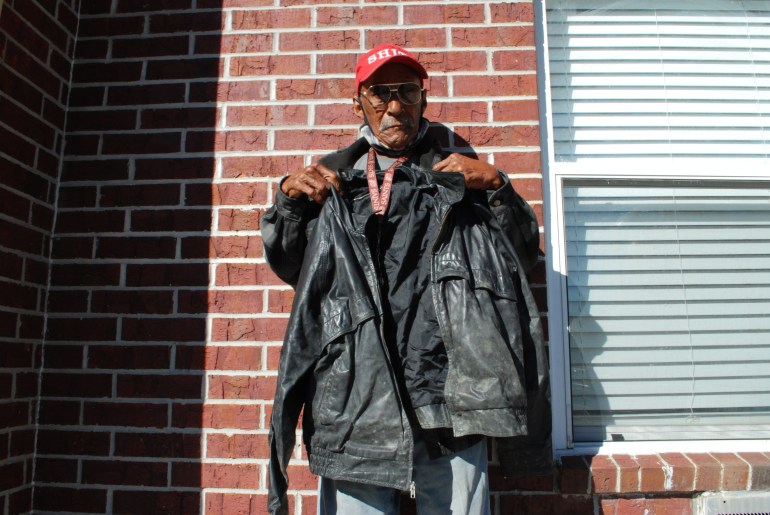
Responses
Atrise Hunter, who is still employed as the sole property manager at Boyd, directed Al Jazeera’s repeated inquiries, in person and over the phone, to Taliafaro, Inc.
Taliafaro management company did not respond to repeated attempts at contact over several months. Back in September, however, Rosalind Swinger, a programme specialist for Taliafaro, told local station WDSU that Jordan Bridges and others “made a real mockery” of efforts to help Boyd residents and “put a nasty spin on Taliafaro for no reason”.
HUD records show that Taliafaro, Inc, has been accused of malfeasance in the past: a 2015 HUD audit found the company “did not always comply with HUD’s requirements … in the disbursement of project funds and collection of fees”, including by charging “unauthorized management fees”.
HUD, meanwhile, which is supposed to perform inspections of its properties every one to three years, had not inspected Boyd Manor since 2016. At that point, Boyd had received a “C” rating in its last three inspections, indicating a health and safety deficiency “calling for immediate attention or remedy”.
When asked why an inspection had not been completed since 2016, HUD told Al Jazeera that inspections were suspended in March 2020 due to the coronavirus pandemic, and resumed in June 2021. HUD said their staff visited in October to assess Hurricane Ida damage.
The National Baptist Convention Housing Commission, which owns Boyd Manor, and which is chaired by Pastor Willie Gable based in New Orleans, did not return multiple calls for comment. Former City Councilmember Kristin Palmer, who lost a bid for a City Council seat and left office in January, expressed acute anger at the actions of various property managers who abandoned seniors post-Ida.
Isis Casanova, the public information officer for the New Orleans Health Department, told Al Jazeera that they evacuated facilities if necessary for the preservation of life, but “according to our records, no such conditions were identified in the two visits to Boyd Manor” during their response to Hurricane Ida. The New Orleans Health Department has not responded to a public records request placed in mid-June regarding such visits.
A month after Hurricane Ida, the Governor’s Office of Elderly Affairs confirmed that it was conducting an investigation into allegations of abuse at Boyd Manor. But Jordan, David, John and the residents say nothing has come of the investigation, and no one has been provided with any updates or information. A representative of the office told Al Jazeera over the phone that they cannot confirm nor deny the existence of an investigation.
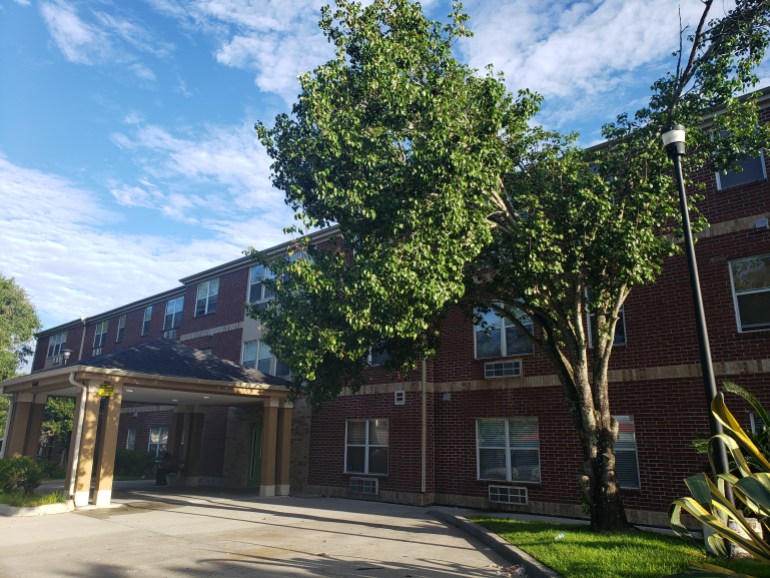
‘You’d have found a lot of dead people here’
A few weeks after the power returned, Jordan and David took lawyer Jamie Paulen to visit Boyd Manor and speak to tenants about their concerns. They were helping residents register for federal emergency aid, apply for public benefits, and call HUD for answers when Taliafaro’s management called the police.
”That was the most shocking thing to me,” Jamie recalls over the phone. “When we were trying to help them they were working against us.” She spoke with police, who eventually acknowledged they weren’t doing anything illegal and left.
Today, residents continue to seek remediation. Some want to leave Boyd. “I need to get out of here,” says Sandra White. “I’m getting depressed.”
Others are simply still trying to recover from the physical and emotional trauma they endured and say their health has been consistently worse since the hurricane. Jimmy Bridges is currently hospitalised with a respiratory illness. Charmayne has been ill since Ida.
“It got much worse. I just can’t get well. It wasn’t just the mould,” she explains. “It was the horror of the storm. It was such a drastic situation – I don’t like to think back over it.”
But every resident Al Jazeera spoke to said the same thing: that Jordan, David, John and the others saved lives.
“Without them young men,” says Yolanda, “you’d have found a lot of dead people here. But they was here every day, making us feel like we were wanted.”
“If it wouldn’t have been for those guys, ain’t no way we would’ve made it,” Michael reflects.
Jordan and David still deliver hot meals, as well as groceries from a local farm, to Boyd Manor once or twice a week. Tatania Riley’s son, Julius, still goes and checks on people there, who call him “grandson”. They continue to support the residents even as Jordan’s home is still being repaired from Ida damage. As the 2022 hurricane season begins, John says he expects that aid will once again be up to Algiers Proud come this summer’s storms. And, they say, they are not finished seeking justice for what Boyd Manor residents endured.